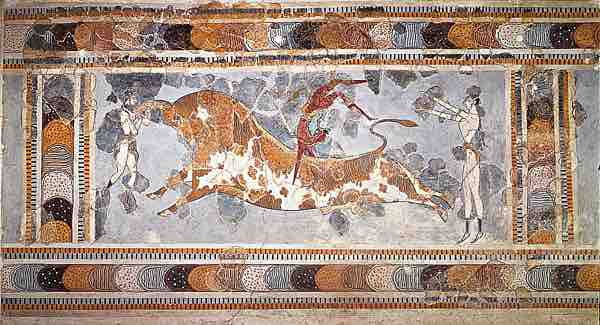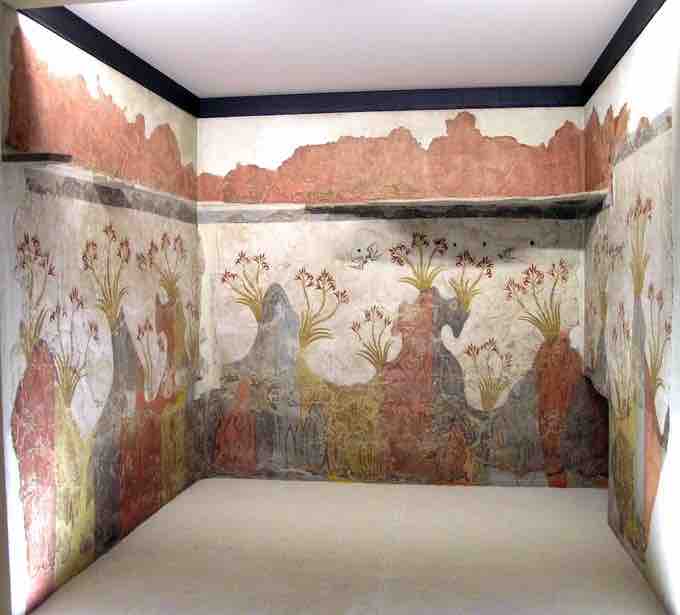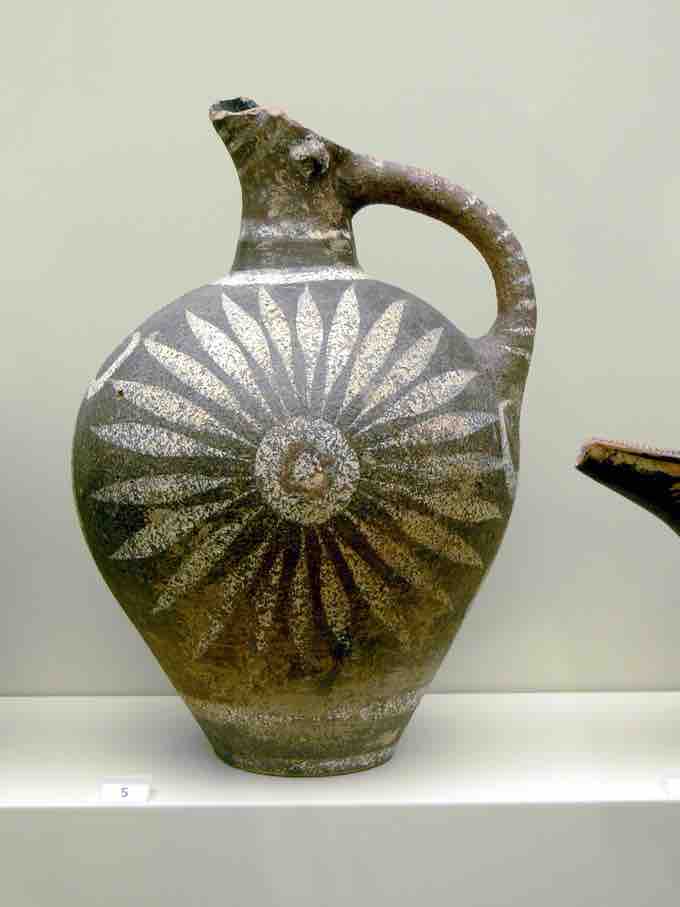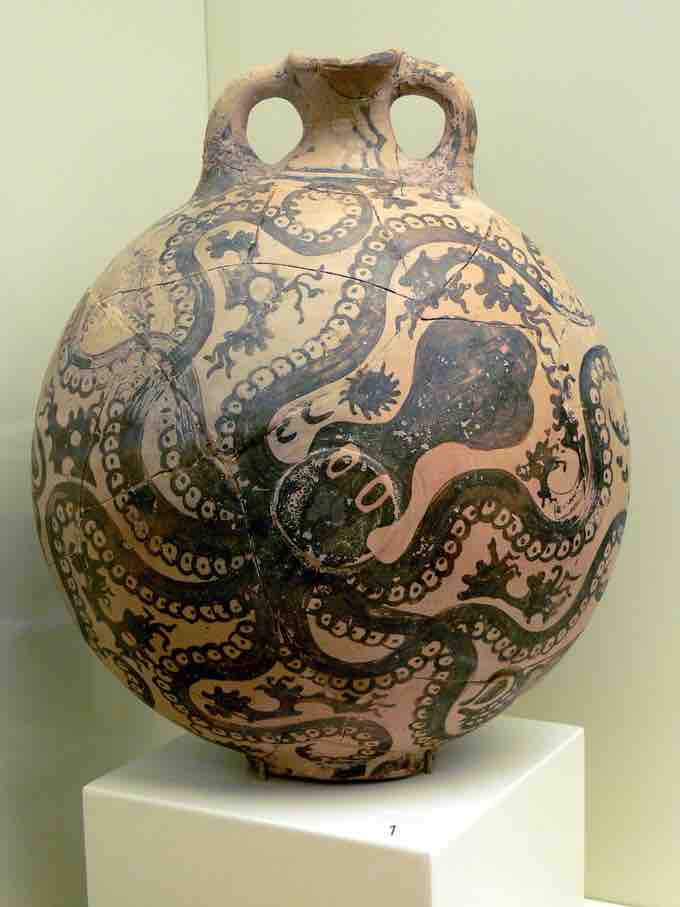Wall Painting
The Minoans decorated their palace complexes and homes with fresco wall painting. Buon fresco is a form of painting where the pigment is painted onto a wet limestone plaster. When the plaster dries the painting also dries, becoming an integral part of the wall. In the Minoan variation, the stone walls were first covered with a mixture of mud and straw, then thinly coated with lime plaster and lastly layers of fine plaster. The Minoans had a distinct painting style with shapes formed by curvilinear lines that add a feeling of liveliness to the paintings. The Minoan color palette is based in earth tones of white, brown, red, and yellow. Black and vivid blue are also used. These color combinations created vivid and rich decoration.
Because the Minoan alphabet, known as Linear A, has yet to be deciphered, scholars must rely on the culture's visual art to provide insight into Minoan life. The frescoes discovered in locations such as Knossos and Akrotiri inform us of the plant and animal life of the islands of Crete and Thera (Santorini), common styles of clothing, and activities practiced. For example, men wore kilts and loincloths. Women wore short-sleeve dresses with flounced skirts whose bodices were open to the navel, allowing their breasts to be exposed.
Fresco depicting three women
This fresco from the complex at Knossos depicts a popular fashion for Minoan women.
Knossos
Fragments of frescoes found at Knossos provide us with glimpses into Minoan culture and ritual. A fresco found on a upper story of the palace has come to be known as Bull Leaping. The image depicts a bull in flying gallop with one person at his horns, another at his feet, and a third, whose skin color is brown instead of white, inverted in a handstand leaping over the bull. While the different skin color of the figures may differentiate male (dark) and female (light) figures, the similarity of their clothing and body shapes (lean with few curves) suggest that the figures may all be male. The figures participate in activity known as bull-leaping. The human figures are stylized, with narrow waists; broad shoulders; long, slender, muscular legs; and cylindrical arms. Unlike the twisted perspective seen in Egyptian or Ancient Near Eastern works of art, these figures are shown in full profile, an element the adds to the air of liveliness.

Bull Leaping
Knossos, Crete, Greece. c. 1450-1400 BCE.
Although the specifics of bull leaping remain a matter of debate, it is commonly interpreted as a ritualistic activity performed in connection with bull worship. In most cases, the leaper would literally grab a bull by his horns, which caused the bull to jerk his neck upwardly. This jerking motion gave the leaper the momentum necessary to perform somersaults and other acrobatic tricks or stunts. Bull Leaping, appears to divide these steps between two participants, with a third extending his arms, possibly to catch the leaper.
Thera
The Minoans settled on other islands besides Crete, including the volcanic, Cycladic island of Thera (present-day Santorini). The volcano on Thera erupted in mid-second millennium BCE, destroying the Minoan city of Akrotiri. Akrotiri was entombed by pumice and ash and since its rediscovery has been referred to as the Minoan Pompeii. The frescoes on Akrotiri were preserved by the blanketing volcanic ash.
The wall paintings found on Thera provide significant information about Minoan life and culture, depicting a highly developed society. A fresco commonly called Flotilla or Akrotiri Ship Procession represents a culture adept at a variety of seafaring occupations. Differences in clothing styles could refer to different ranks and roles in society. Deer, dolphins, and large felines point to a sense of biodiversity among the islands of the Minoan civilization.
Flotilla, or Akrotiri Ship Procession
This panoramic fresco depicts the Minoans as a highly developed civilization.
In one room is a wall painting known as the Landscape with Swallows, or as the Spring Fresco. It depicts a whimsical, hilly landscape with lilies sprouting from the ground. Sparrows, painted in blue, white, and red, swoop around the landscape. The lilies sway gracefully and the hills create an undulating rhythm around the room. The fresco does not depict a naturalistic landscape, but instead depicts an essence of the land and nature, whose liveliness is enhanced through the colors and curvilinear lines.

Landscape with Sparrows, or Spring Fresco
Akrotiri, Thera, Greece. c. 1650 BCE.
Vase Painting
Minoan ceramics and vase painting are uniquely stylized and are similar in artistic style to Minoan wall painting. As with Minoan frescoes, themes of nature and marine life are often depicted on their pottery. Similar earth-tone colors are used, including black, white, brown, red, and blue.
Kamares ware, a distinctive type of pottery painted in white, red, and blue over a black backdrop, is created from a fine clay. The paintings depict marine scenes, as well as abstract floral shapes, and they are often include abstract lines and shapes, including spirals and waves. These stylized floral shapes include lilies, palms, papyrus, and leaves and fill the entire surface of the pot with bold designs. The pottery is named for the location where it was first found in the late nineteenth century, at a cave sanctuary at Kamares, on Mt. Ida. This style of pottery is found throughout the island of Crete as well in a variety of locations on the Mediterranean.

Kamera Ware Vessel
Kamares ware vessel with abstract floral design. Minoan. 2100-1700 BCE.
The Marine style emerged during the late Minoan period. As the name suggests, the decoration on these vessels take their cue from the sea. The vessels are almost entirely covered with sea creatures such as dolphins, fish, and octopi, along with seaweed, rock, and sponges. Unlike their Kamares-ware predecessors, the light and dark color scheme is inverted: the figures are dark on a light background. Like the landscape frescoes at Thera, these paintings demonstrate a keen understanding and intimate knowledge of the marine environment.
In the Marine style Octopus Vase from the city of Palaikastro, the octopus wraps around the jug, mimicking and accentuating its round shape. The octopus is painted in great detail, from each of its distinct stylized suckers to its bulbous head and the extension of its long tentacles. The surface of this vessel is covered by the main image; bits of seaweed fill the negative space. This filling of the empty space with additional images or designs is another characteristic of Minoan Marine Style pottery. The style is known as horror vacui, which is Latin for "fear of empty space." The same aesthetic is seen later, in Greek Geometric pottery.

Octopus Vase
Octopus Vase. Palaikastro, Crete, Greece. c. 1500 BCE.